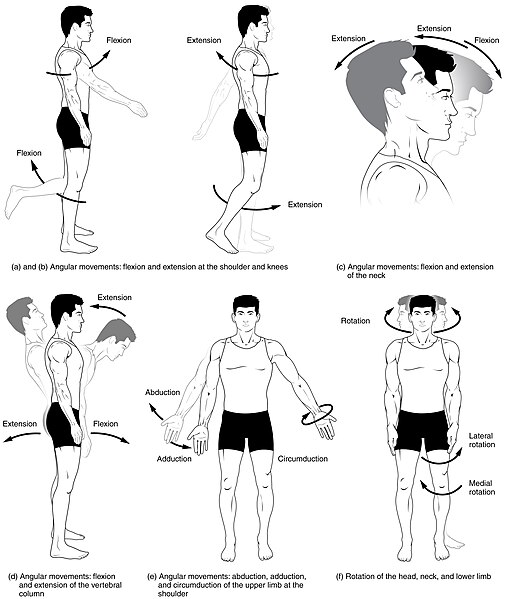3.Human Physiology
3.5 Movement
movement
Dr V Malathi
Human movement is a complex process involving the coordinated action of various systems in the body.
Types of Movements
- Flexion and Extension:Flexion and extension are motions of the body or limbs that occur in the sagittal plane and can be either anterior or posterior. In terms of the vertebral column, extension refers to a posterior-directed motion, such as straightening from a flexed posture or bending backward, whereas flexion, or anterior flexion, is the anterior (forward) bending of the neck or body. Bending the body or neck to the right or left is known as lateral flexion. The corresponding intervertebral disc and the joints of the vertebral column are both involved in these movements.
- Abduction and Adduction: Medial-lateral motions of the limbs, fingers, toes, or thumb are involved in abduction and adduction actions, which take place inside the coronal plane.
-
- Abduction: Moving a limb away from the midline of the body (e.g., raising the arms sideways).
- Adduction: Moving a limb towards the midline of the body (e.g., lowering the arms to the sides).
3.Rotation: There are three possible locations for rotation: the ball-and-socket joint, the pivot joint, and the spinal column. The twisting motion that results from the accumulation of the minute rotational movements possible between neighboring vertebrae produces the rotation of the neck or body.
The ball-and-socket joints in the hip and shoulder can also rotate. Here, the anterior surface of the arm or thigh is moved either toward or away from the body’s midline as a result of the humerus and femur rotating about their long axes.
4.Circumduction: It is the movement of a body region in a circular manner. It is a combination of flexion, extension, abduction, and adduction (e.g., moving the arm in a circular motion).In this type of movement one end of the body region being moved stays relatively stationary while the other end describes a circle.
5. Pronation and Supination: These are movements of the forearm. The upper limb is held adjacent to the torso in the anatomical position, palm facing forward. This shows the forearm in a supinated position. The ulna and radius are parallel to one another in this configuration. When the forearm is in the pronated posture, the ulna and radius form an X, and the palm faces backward.
-
- Pronation: Rotating the forearm so the palm faces downwards.
- Supination: Rotating the forearm so the palm faces upwards.
6.Dorsiflexion and Plantar flexion : The ankle joint is a hinge joint, and its movements include dorsiflexion and plantar flexion. Dorsiflexion is the lifting of the foot’s front so that its top travels (upward) toward the anterior leg; plantar flexion is the lifting of the foot’s heel off the ground or pointing the toes downward. The ankle joint can only be moved in certain ways.
7. Inversion and eversion : These are complex movements that involve the multiple plane joints among the tarsal bones of the posterior foot (intertarsal joints) .They are not motions that take place at the ankle joint.
These are vital movements that provide fast side-to-side direction changes during energetic sports like basketball, racquetball, or soccer as well as help to support the foot when running or walking on an uneven surface.
- Inversion : turning of the foot to angle the bottom of the foot toward the midline,
- Eversion : turns the bottom of the foot away from the midline.
- The foot has a greater range of inversion than eversion motion.
8.Depression and Elevation : In this type of movement the scapula or mandible moves upward (Elevation) and downward (depression). The depression and elevation movements of the scapula is utilized to shrug the shoulders.
Similar to this, depression of the mandible is the downward movement that results in the opening of the mouth, and elevation of the mandible is the upward movement of the lower jaw used to seal the mouth or bite on something.

“Body Movements “ by Tonye Ogele CNX, creativecommons.org, via Wikimedia Commons is licensed under CC BY-SA 3.0
Systems Involved
- Skeletal System: Provides the framework and support for movement. The skeletal system is composed of bones, cartilage, and ligaments. Each bone serves a particular function and varies in size, shape, and strength. The general functions of the skeletal system include: Supporting the body, facilitating movement, protecting internal organs, producing blood cells, storing and releasing minerals and fat
Video Links for further understanding
2.Muscular System: Muscles, one of the four primary tissue types of the body, contract and relax to produce movement. There are three different types of muscle tissue in the body: cardiac, smooth, and skeletal muscle . A characteristic shared by all three muscle tissues is excitability, which is the ability of their plasma membranes to transition from polarized to depolarized states and to transmit an electrical wave known as an action potential throughout the membrane’s whole length. Muscles are surrounded by fibrous connective tissue, or fascia.
Muscles work as antagonistic pairs i.e., when one muscle contracts, the other muscle relaxes. This contraction pulls on the bones and assists with movement. Muscle fibers shrink during contraction and lengthen during rest. The neurological system mediates this contraction and relaxation process. Additionally, muscles help to maintain the body’s posture. This is accomplished by contracting the muscles in the trunk, which is maintained during sitting or standing.
Further Reading
To know more about the muscular system visit the chapter on muscular system fromMedical Terminology for Healthcare Professions
To know more about the muscular contraction visit the chapter on Muscle Contraction and Locomotion from Concepts of Biology – 1st Canadian Edition
3.Nervous System: Sends signals to muscles to initiate and control movement.
4. Cardiovascular System: Supplies oxygen and nutrients to muscles.
5. Respiratory system : provides oxygen for muscles.
Test your Understanding

